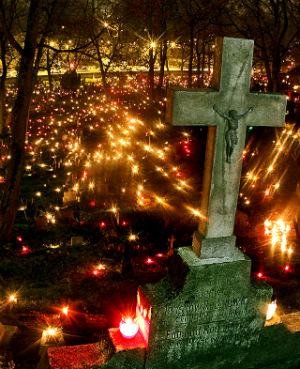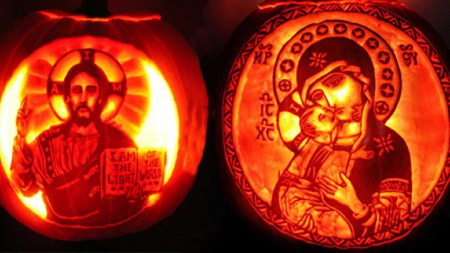Altar Frontal
FREE Catholic Classes
The frontal ( antipendium, pallium altaris ) is an appendage which covers the entire front of the altar, from the lower part of the table ( mensa ) to the predella , and from the gospel corner to that of the epistle side. Its origin may probably be traced to the curtains or veils of silk, or of other precious material, which hung over the open space under the altar, to preserve the shrines of the saints usually deposited there. Later, these curtains were converted into one piece of drapery which covered the whole front of the altar and was suspended from the table of the altar. The use of a frontal which covers only a small portion of the front of the altar is forbidden (Cong Sac. Rit., 10 September, 1898). If the altar is so placed that its back can be seen by the people, that part should likewise be covered with an antipendium (Caerem. Episc., I, iii, 11). Its material is not prescribed by the rubrics. It is sometimes made of precious metals, adorned with enamels and jewels, of wood, painted, gilt, embossed, and often set with crystals or of cloth of gold, velvet, or silk embroidered and occasionally enriched with pearls, but it is usually of the same material as that of the sacred vestments. It is evidently intended as an ornament of the altar (Rubr. Gen. Miss., tit.). Hence if the altar is made of wood or marble, and its front is beautifully painted or decorated, or if the table is supported by columns, and a reliquary is placed under it, it may be considered sufficiently ornamented, and the antipendium would not be necessary ; nevertheless, even in such cases, on solemn occasions more precious and elaborate ones should be used (Caerem. Episc., I, xii, 11). The antipendium may be ornamented with images, pictures of Christ, representations of some fact of His life or such as refer to the Eucharistic Mystery, or with emblems that refer in some manner to the Blessed Sacrament -- a lamb, a pelican, the chalice and host, etc. Pictures of the saint in whose honour the altar is dedicated to God, and emblems referring to such saint, may be used. It is forbidden to ornament the black antipendium with skulls, cross-bones, etc. (Caerem. Episc., II, xi, 1). The antipendium may be fastened to little hooks or buttons, which are attached to-the lower part of the table of the altar or it may be pinned to one of the lower altar-cloths or attached to a light wooden frame which fits tightly in the space between the mensa and the predella. A guard about three inches wide (plinth), made of wood suitably painted. or of polished metal, may be placed at its lower extremity, resting on the predella, so as to prevent its being easily injured by those who move about the altar. Regularly, the colour of the antipendium should correspond with the colour of the feast or office of the day (Caerem. Episc., I, xii, 11). The Missal (Rubr. Gen., xx) says this should be the case quoad fieri potest , by which the Missal does not imply that one colour may be used ad libitum for another, but that the more precious antipendia of gold, silver, embroidered silk, etc., in colours not strictly liturgical, may be used on solemn occasions, although they do not correspond in colour with the feast or office of the day (Van der Stappen vol. III, q. 43, ii). The following are exceptions to the general rule: (1) When the Blessed Sacrament is publicly exposed the antipendium must be white, whatever the colour of the vestments may be. If, however, the Exposition takes place immediately after Mass, or Vespers, the antipendium of the colour of the Mass, or Vespers, may be retained if the celebrant does not leave the sanctuary between the Mass, or Vespers, and the Exposition; but if on these occasions he vests for the exposition outside the sanctuary, the antipendium if not white must be exchanged for a white one. (2) In solemn votive Masses the colour of the antipendium must be that of the vestments. In private votive Masses ( missae lectae ) its colour corresponds to that of the office of the day. In private votive Masses celebrated solemnly, i.e. with deacon and subdeacon, or in chant ( missae cantatae ) it is proper that its colour correspond with that of the vestments. (3) During a solemn Requiem Mass at an altar in the tabernacle of which the Blessed Sacrament is kept, the black antipendium cannot be used (Cong. Sac. Rit., 20 March, 1869), but one of a violet colour should take its place. The Ephemeides Lit., (XI, 663, 1897), states that this decree was revoked by a subsequent decree of the same Congregation, 1 December, 1882. It seems strange that the former decree is retained in the latest edition of the Decrees of the Cong. Sac. Rit. The latter decree is an answer to the question: Under these circumstances may the antipendium and the conopoeum (cover of the tabernacle) be black? The answer seems to pass over the antipendium, and merely says: "At least the canopy over the tabernacle should be of a violet colour". The antipendium need not be blessed.
Join the Movement
When you sign up below, you don't just join an email list - you're joining an entire movement for Free world class Catholic education.
-

-
Mysteries of the Rosary
-
St. Faustina Kowalska
-
Litany of the Blessed Virgin Mary
-
Saint of the Day for Wednesday, Oct 4th, 2023
-
Popular Saints
-
St. Francis of Assisi
-
Bible
-
Female / Women Saints
-
7 Morning Prayers you need to get your day started with God
-
Litany of the Blessed Virgin Mary
All Saints' Day, Halloween and All Souls' Day: What's the difference?
-

Should Christians Celebrate Halloween?
-

Since when did Halloween become a Christian holiday?
-
ADORABLE: A Little Boy's Heartfelt Lunchtime Prayer
-
Scientists Decode 3,000-Year-Old Babylonian Tablet, Revealing Potential Location of Noah's Ark
Daily Catholic
 Daily Readings for Friday, November 01, 2024
Daily Readings for Friday, November 01, 2024 St. Valentine Berrio-Ochoa: Saint of the Day for Friday, November 01, 2024
St. Valentine Berrio-Ochoa: Saint of the Day for Friday, November 01, 2024 Litany of the Saints: Prayer of the Day for Friday, November 01, 2024
Litany of the Saints: Prayer of the Day for Friday, November 01, 2024- Daily Readings for Thursday, October 31, 2024
- St. Wolfgang: Saint of the Day for Thursday, October 31, 2024
- Memorare: Prayer of the Day for Thursday, October 31, 2024
![]()
Copyright 2024 Catholic Online. All materials contained on this site, whether written, audible or visual are the exclusive property of Catholic Online and are protected under U.S. and International copyright laws, © Copyright 2024 Catholic Online. Any unauthorized use, without prior written consent of Catholic Online is strictly forbidden and prohibited.
Catholic Online is a Project of Your Catholic Voice Foundation, a Not-for-Profit Corporation. Your Catholic Voice Foundation has been granted a recognition of tax exemption under Section 501(c)(3) of the Internal Revenue Code. Federal Tax Identification Number: 81-0596847. Your gift is tax-deductible as allowed by law.






 Daily Readings for Friday, November 01, 2024
Daily Readings for Friday, November 01, 2024 St. Valentine Berrio-Ochoa: Saint of the Day for Friday, November 01, 2024
St. Valentine Berrio-Ochoa: Saint of the Day for Friday, November 01, 2024 Litany of the Saints: Prayer of the Day for Friday, November 01, 2024
Litany of the Saints: Prayer of the Day for Friday, November 01, 2024


